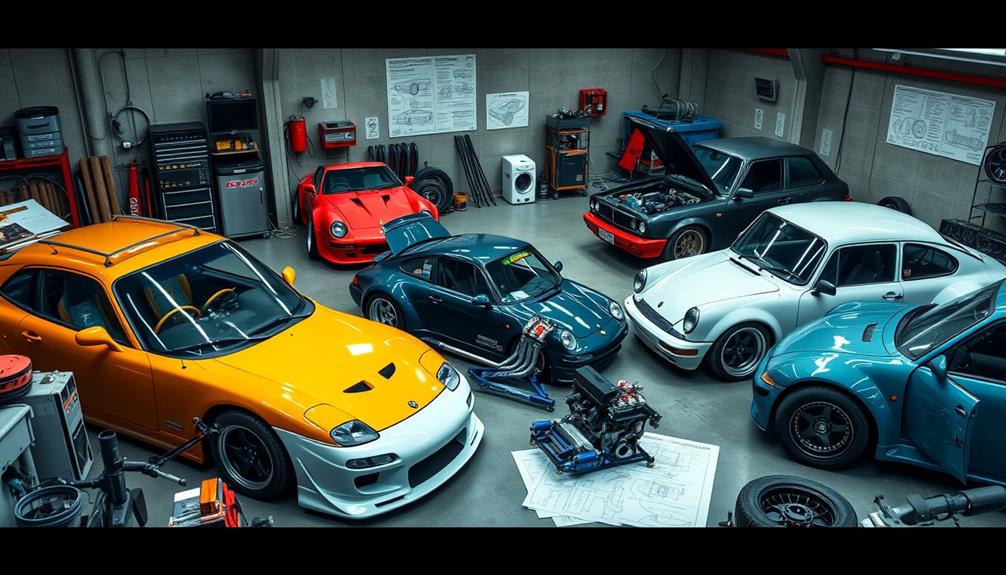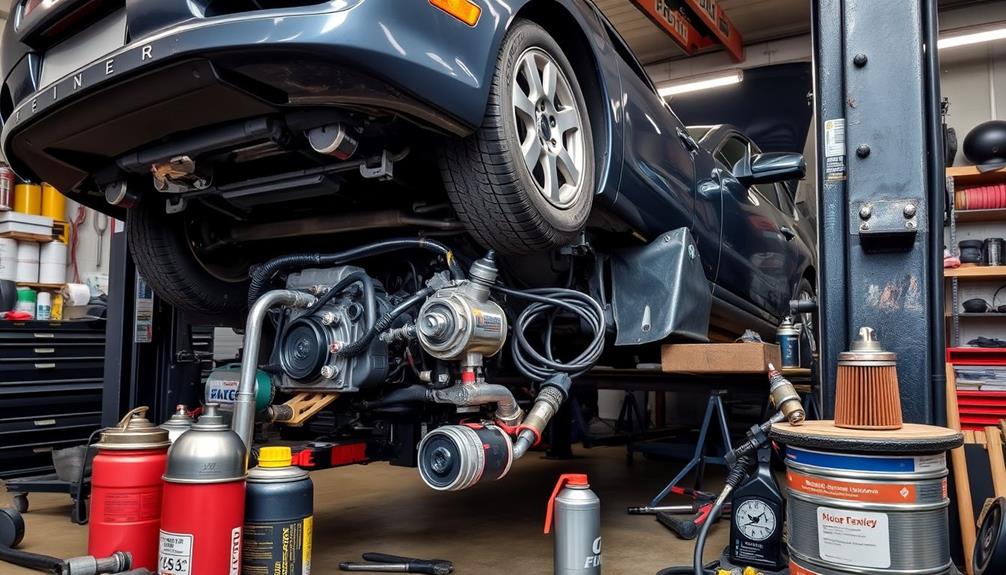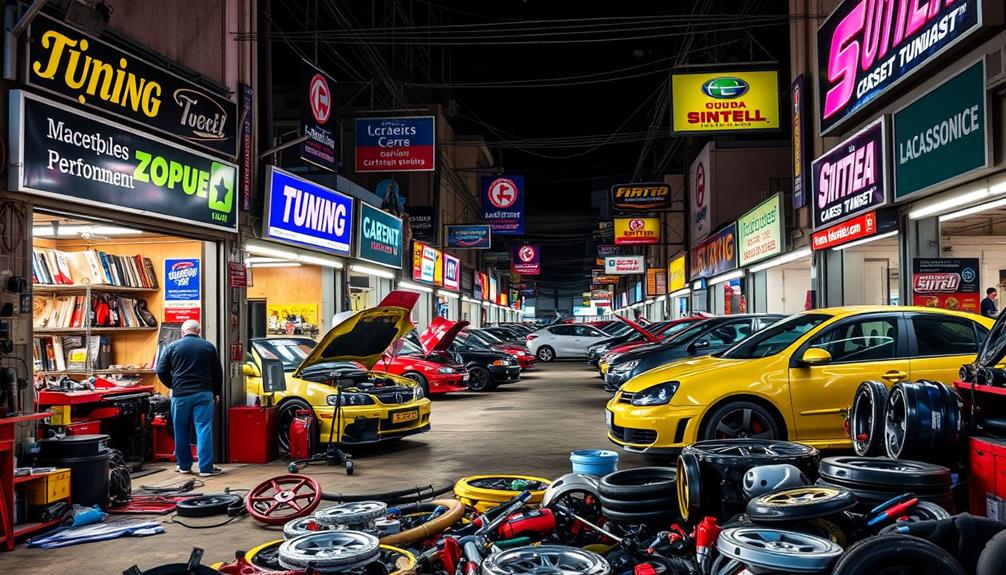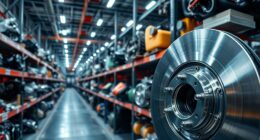Exhaust systems impact both sound and performance, but balancing the two can be tricky. Performance-focused setups, like straight-through mufflers, boost power and airflow but often make your vehicle louder and more aggressive. Sound-dampening components, such as resonators or chambered mufflers, reduce noise but may slightly limit airflow. To get the right mix of sound and performance, consider how your engine, materials, and chamber design work together. For more tips, keep exploring what options suit your goals.
Key Takeaways
- Chambered mufflers produce deep sounds while reducing backpressure, enhancing performance and engine efficiency.
- Straight-through mufflers maximize airflow for increased power but generate louder, more aggressive exhaust sounds.
- Material choices like stainless steel improve durability and maintain performance without compromising sound quality.
- Exhaust chamber design and resonators allow tuning of sound profiles without negatively impacting flow or performance.
- Regulations often limit noise levels, influencing muffler selection to balance sound preferences with legal compliance.
Understanding Exhaust System Components

Understanding the components of an exhaust system is essential for grasping how your vehicle manages emissions and performance.
Knowing your exhaust system components helps optimize vehicle emissions and performance.
The exhaust manifold collects gases from each cylinder’s exhaust port and channels them into one outlet. Made from heat-resistant materials like cast iron or stainless steel, it bolts directly to the cylinder head, ensuring efficient gas flow. The design of the manifold can affect engine efficiency and emissions. Properly designed manifolds can also reduce exhaust backpressure, which improves overall engine performance. Positioned downstream is the catalytic converter, which transforms harmful pollutants such as carbon monoxide and hydrocarbons into less damaging substances like carbon dioxide and water vapor, helping you meet emission standards.
Connecting all parts are exhaust pipes, which provide a continuous path for gases to exit the vehicle. These pipes are designed to maintain smooth flow, minimizing backpressure that could reduce engine efficiency.
Proper sealing and secure mounting with clamps and gaskets keep the system effective and leak-free.
Types of Mufflers and Their Sound Profiles

Are you curious about how different muffler types influence your vehicle’s sound? Each muffler offers a unique tone.
Chambered mufflers create a deep, resonant sound by using internal chambers to manipulate sound waves. They are known for their raspy, aggressive tone, making them popular among enthusiasts seeking a bold exhaust note. Chambered mufflers can also enhance engine performance by reducing backpressure, further influencing sound and power. Turbo mufflers produce a raspy, sharper noise with perforated tubes lined with sound-absorbing material, making them quieter. Straight-through mufflers generate a loud, aggressive exhaust note because of their straight, unobstructed path for gases. This design often results in increased exhaust flow, which can improve performance. Glasspack mufflers balance noise reduction with performance, offering a muffled yet sporty sound through fiberglass packing around a perforated tube. Resonator mufflers are designed to fine-tune or alter the exhaust note, making it more pleasing or aggressive based on their chambers and resonators. Your choice depends on whether you prioritize sound style or quiet operation.
How Muffler Materials Impact Performance and Durability

The materials used in mufflers directly influence your vehicle’s performance and how long the system lasts. Aluminized steel withstands high temperatures, resists rust, and maintains structural integrity, improving exhaust flow and thermal efficiency. Aluminized steel’s ability to resist corrosion helps prevent buildup that can restrict exhaust gases and degrade performance over time. Additionally, ongoing research into AI Safety aims to enhance safety measures for advanced vehicle systems, including exhaust management. Stainless steel offers higher strength, better rust resistance, and a longer lifespan, ensuring consistent performance over time. Materials with superior corrosion protection reduce damage from environmental exposure, extending your muffler’s durability. Lightweight options like aluminum coatings help with weight reduction, boosting fuel efficiency and vehicle handling. Durability depends on selecting high-quality materials, with stainless steel providing the longest lifespan and aluminized steel offering a good balance of cost and performance. Proper material choice minimizes maintenance needs and guarantees your exhaust system remains effective under various driving conditions.
Sound Levels and Regulations for Different Vehicles

Vehicle exhaust systems must meet specific sound level regulations that vary by state and vehicle type. For example, California limits passenger vehicles to 95 dB(A), while Washington restricts cars and light trucks to 72-78 dB(A) and motorcycles to 78-82 dB(A). Enforcement often relies on officer discretion, with roadside assessments common. Testing protocols differ: California measures at 20″ from the outlet, while Washington uses RPM-based evaluations. Key distinctions include motorcycle limits and heavy truck thresholds. The table below summarizes regulations:
| Vehicle Type | Sound Limit (dB(A)) | Notes |
|---|---|---|
| Passenger Vehicles | 95 | California standard |
| Motorcycles | 78-82 | Washington limits |
| Light Trucks | 72-78 | Washington limits |
| Heavy Trucks | 86-90 | Washington limits |
| Modified Exhausts | Varies, illegal if exceeding limits | Always prohibited if loud |
Staying compliant involves regular testing, certified parts, and proper maintenance. Ensuring exhaust systems meet these standards is essential for legal driving and avoiding fines.
Engine Compatibility and Its Effect on Exhaust Sound
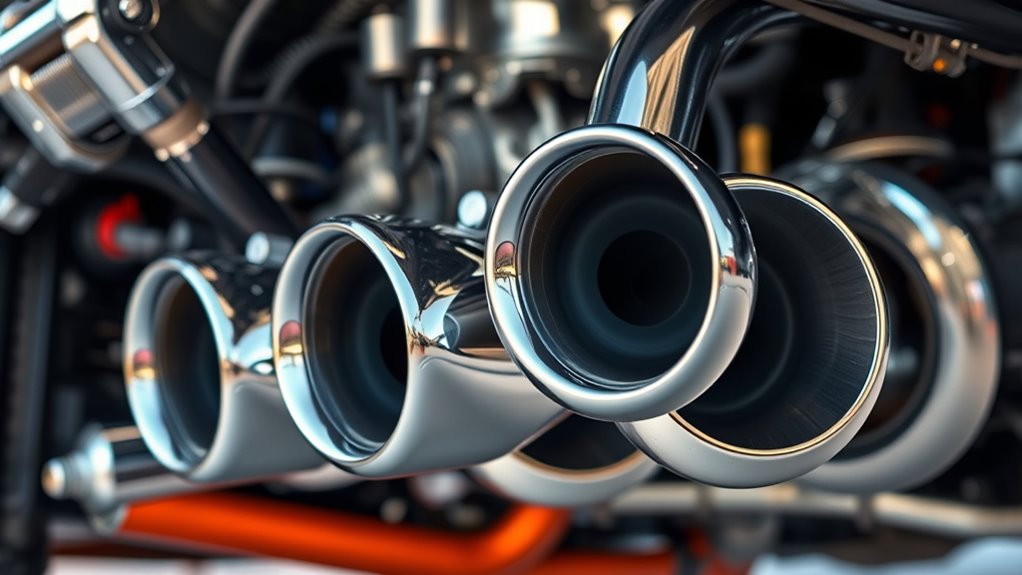
Engine compatibility plays a crucial role in shaping the exhaust sound, as different engine configurations produce unique acoustic signatures. Your engine type—whether V8, V6, or inline-4—determines the firing order and cylinder layout, which directly influence the exhaust tone. Different engine types produce distinct sound profiles that are characteristic of their design. The design of your cylinder head and valve train (pushrod or overhead cam) further impacts how sound waves are generated and exit the engine. Timing and duration of exhaust valve opening also shape the note you hear. Additionally, engine swaps can drastically alter the exhaust sound if paired with different configurations or exhaust upgrades. These factors combine to craft a distinct sound profile, meaning your engine’s compatibility with certain exhaust components will ultimately define the character and pitch of your vehicle’s exhaust note. Understanding engine design principles helps explain why certain exhaust systems sound different on various engines. Recognizing engine configuration effects can aid in selecting the optimal exhaust setup for desired sound and performance.
Trade-offs Between Noise and Power Gains

Choosing an exhaust setup often involves balancing the desire for a louder, more aggressive sound against the goal of maximizing horsepower. Larger pipes deepen the tone but can reduce low-end torque due to slower exhaust velocity. Longer pipes enhance bass but may restrict flow, limiting top-end power. Material selection affects sound quality and performance, with different metals providing unique sonic characteristics. Smooth bends minimize turbulence and raspiness, while sharp bends create unwanted high-frequency noise. Straight-through mufflers improve flow and power but increase volume and drone, whereas chambered mufflers produce a deeper sound at the expense of flow efficiency. High-flow catalysts boost power but risk failing emissions. Resonators can reduce drone without major flow loss. Additionally, exhaust flow dynamics play a crucial role in optimizing performance and sound. Properly designed exhaust systems can also help in reducing backpressure, which is essential for efficient engine operation. Ultimately, optimizing backpressure improves scavenging and power at specific RPMs, but louder systems often compromise noise limits and cabin comfort.
The Role of Chamber Design in Sound and Flow
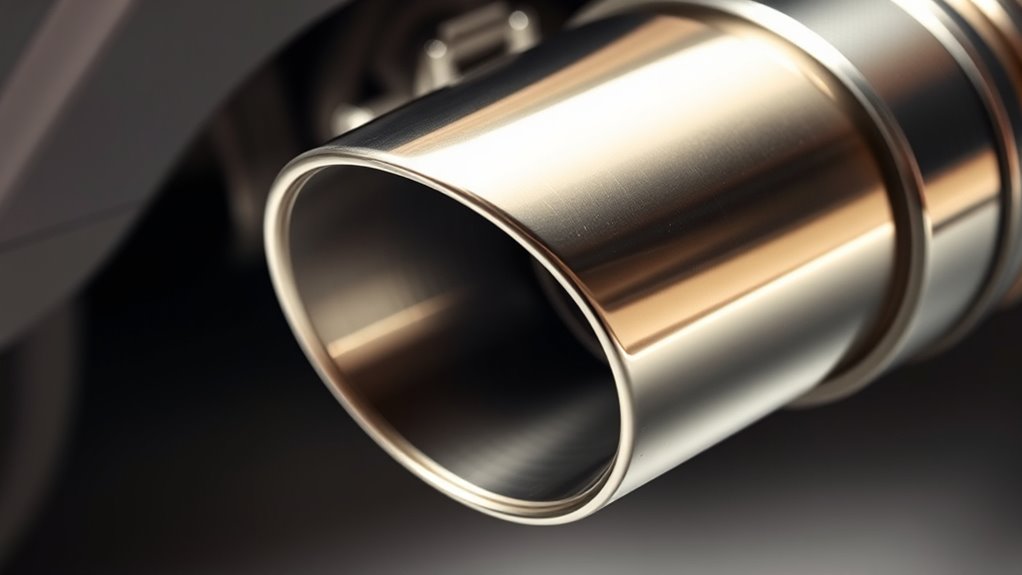
Chamber design plays a crucial role in shaping both the sound and flow characteristics of an exhaust system. You can manipulate sound frequencies and pulses by using multi-chamber structures, baffles, and walls. Known for muffler design featuring chambers and angled deflectors, Technologies like Flowmaster’s Delta Flow® use angled deflectors and three chambers to cut interior resonance while maintaining a deep exterior tone. Chamber arrangements allow you to customize exhaust notes, from a low rumble to a choppy idle. They also create a scavenging effect, accelerating exhaust pulses to boost engine efficiency and power. Chamber tuning emphasizes low-frequency sounds for a throaty roar and manages resonance to reduce drone, all while balancing flow. Directional flow redirection and pressure wave manipulation improve scavenging and reduce backpressure, ensuring better flow without sacrificing sound quality.
Comparing Performance Mufflers: Brands and Models

When comparing performance mufflers, it’s important to contemplate how each brand’s design and materials influence sound, flow, and durability. Flowmaster mufflers deliver a deep, aggressive tone, ideal for muscle cars and trucks, with designs that maximize power through efficient flow. Subtopic 1 Their stainless steel construction and Delta Flow chambered technology are engineered to produce a growling sound while maintaining longevity. MagnaFlow offers a smooth, refined sound with stainless steel construction, emphasizing durability and high-quality acoustics. Borla focuses on high-performance, using premium materials like titanium and carbon fiber, and provides long-term warranties, making them a top choice for enthusiasts seeking reliability. While Flowmaster and Borla cater to racing and high-flow needs, MagnaFlow emphasizes a balanced, deep tone suitable for daily driving. Each brand’s configuration and material selection directly impact your vehicle’s sound, performance, and longevity, helping you tailor your exhaust system to your preferences. Additionally, exhaust system customization allows drivers to select mufflers that best suit their sound and performance goals.
Motorcycle Exhaust Systems: Customization and Sound Options
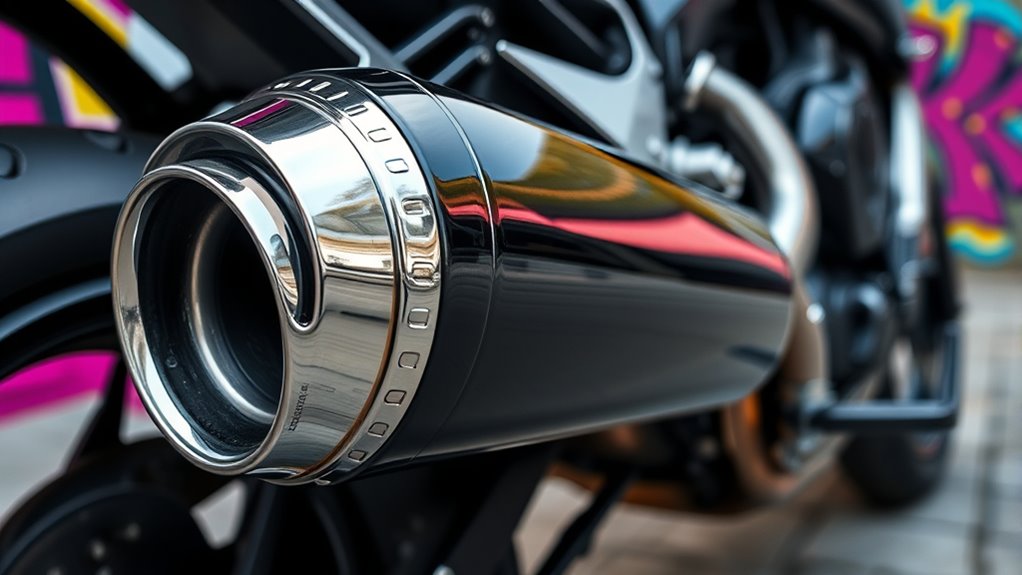
Motorcycle exhaust customization offers a variety of options to enhance both sound and performance, allowing you to tailor your ride to your preferences. Slip-on exhausts swap out only the muffler, providing quick upgrades in sound and style without affecting fuel settings. Full systems replace headers, pipes, and mufflers, boosting horsepower but often requiring ECU tuning.
Two-into-one setups reduce weight and improve lean angles, while separate dual exhausts optimize airflow for V-twins, adding weight. Shorty mufflers deliver aggressive sound but may lack performance benefits. Material choices like titanium and carbon fiber reduce weight and improve durability, while ceramic coatings enhance heat management. Adjusting baffle design, pipe diameter, and routing helps fine-tune sound, giving you control over volume, tone, and resonance to match your riding style. Incorporating antique elements into your exhaust design can also create a distinctive look that complements a personalized motorcycle aesthetic. Additionally, selecting the right exhaust system materials can influence both the sound quality and overall performance characteristics of your bike.
Balancing Interior Comfort With Exterior Sound Expectations
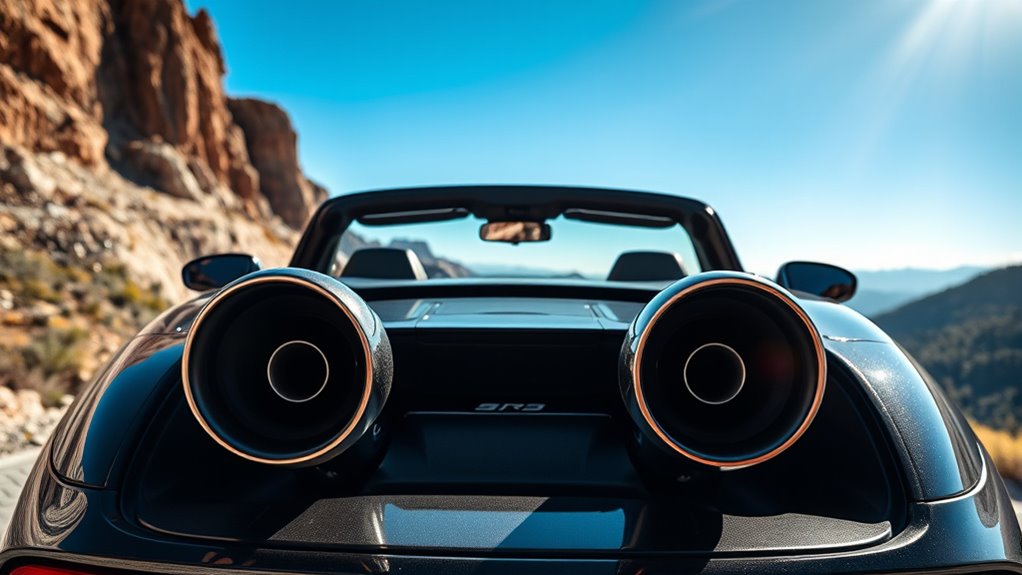
Balancing interior comfort with exterior sound expectations requires careful consideration of both material choices and pipe design. Selecting the right materials impacts acoustics; stainless steel offers crisp tones, titanium produces higher-pitched sounds, and aluminum offers a mellow, subdued tone. Stock exhaust systems are designed for general use and compliance, typically balancing performance, efficiency, and noise reduction, but aftermarket options can enhance sound and performance. Using fiberglass or ceramic insulation can dampen vibrations, reducing interior noise. Pipe geometry also matters: wider diameters improve airflow and lessen raspiness, while mandrel-bent tubing minimizes turbulent noise. Incorporating balance tubes helps create a smoother exhaust note. Shorter systems boost exterior volume at the cost of cabin comfort, and resonators target specific frequencies for refinement. Managing backpressure with straight-through mufflers and adjustable valves allows you to switch between quiet and loud modes, ensuring both a refined interior environment and a satisfying exterior exhaust presence.
Frequently Asked Questions
How Do Different Muffler Designs Affect Overall Vehicle Performance?
Different muffler designs directly impact your vehicle’s performance by influencing exhaust flow and backpressure.
For example, straight-through mufflers reduce backpressure, boosting horsepower and fuel efficiency. Chambered mufflers may add sound customization but can create more resistance, slightly lowering performance.
Turbo designs balance noise and flow, optimizing engine breathing.
Ultimately, choosing the right muffler design helps you enhance power, efficiency, and sound, tailoring your vehicle to your driving preferences.
Can Upgrading My Exhaust System Improve Fuel Economy?
They say “you get what you pay for,” and upgrading your exhaust might help, but don’t expect miracles.
A high-flow system reduces backpressure, which can slightly improve efficiency, saving you about 1-3%. However, it’s not a guaranteed fuel economy boost unless paired with other mods like tuning.
What Are the Best Muffler Options for Noise-Sensitive Neighborhoods?
If you’re looking to keep noise levels down in sensitive neighborhoods, choose mufflers like Flowmaster’s Mild lineup or Magnaflow’s offset-inlet designs. These options produce near-stock sounds, comply with local noise ordinances, and still offer decent performance.
Pair them with resonators or tailpipe extensions for extra quieting.
Always verify your local rules and use a decibel meter during testing to ensure your setup stays within legal limits.
How Does Exhaust Sound Influence Vehicle Resale Value?
You should know that exhaust sound considerably affects your vehicle’s resale value. Loud, aftermarket systems might appeal to enthusiasts but can turn off general buyers, leading to lower offers or difficulty selling.
Keeping the exhaust stock or reverting to OEM helps preserve value. If you’ve upgraded, documenting the modifications and restoring factory parts before selling can maximize your resale potential and attract a broader audience.
Are There Legal Restrictions on Aftermarket Exhaust Modifications?
Think of your vehicle as a voice in a bustling city, where laws serve as the city’s silent guardians. You’re only allowed to amplify your voice within certain limits.
Legally, aftermarket exhausts must respect noise and emission rules; exceeding these can lead to fines or vehicle restrictions.
To stay compliant, guarantee your modifications meet local regulations, pass inspections, and avoid tampering with emission controls, keeping your vehicle’s voice lawful and clear.
Conclusion
Choosing the right exhaust system balances sound and performance to suit your driving style. Did you know that a well-designed muffler can improve horsepower by up to 10%? Whether you prioritize a deep roar or quiet comfort, understanding the components and options helps you make the best decision. Remember, the right system not only enhances your vehicle’s sound but also boosts efficiency and durability—making every drive more enjoyable.



